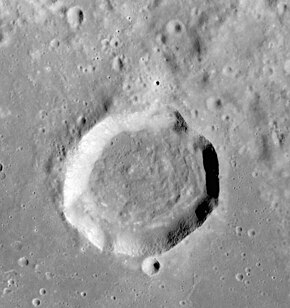 | |
| Coordinates | 17°36′N 31°18′E / 17.6°N 31.3°E |
|---|---|
| Diameter | 30 km |
| Depth | 1.5 km |
| Colongitude | 329° at sunrise |
| Eponym | Marcus Vitruvius Pollio |




Vitruvius is a small lunar impact crater that lies on the northern edge of the Mare Tranquillitatis. To the east is the crater Gardner, and to the northeast is Fabbroni. To the north-northwest is the elongated Mons Vitruvius mountain, and beyond is the valley where the Apollo 17 mission landed.
The rim of Vitruvius is somewhat circular, but the sides are uneven to the north and east. The rim is highest to the northwest. The interior floor is uneven, with some low rises in the southwest. A small crater is attached to southern outer rim. The surroundings grow more rugged to the north of the crater. The crater was named after the ancient Roman engineer and architect Vitruvius.[1]
Vitruvius is a crater of Upper (Late) Imbrian age.[2]
- ^ "Vitruvius (crater)". Gazetteer of Planetary Nomenclature. USGS Astrogeology Research Program.
- ^ The geologic history of the Moon. USGS Professional Paper 1348. By Don E. Wilhelms, John F. McCauley, and Newell J. Trask. U.S. Government Printing Office, Washington: 1987. Table 11.2.